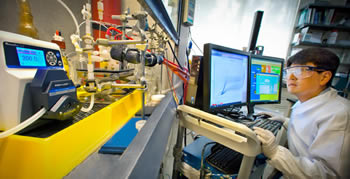Energy Efficiency and Sustainable Energy

Fuel Cell research,
Environmental Energy Technologies Division
There’s enough power in an hour’s worth of global sunlight to supply an entire year’s worth of human energy demands with no carbon emissions to exacerbate global warming. But until we are able to make full and effective use of this bounty, energy efficiency remains the most readily available means of reducing our dependence on foreign oil.
Energy efficiency
Contrary to popular belief, the terms “energy efficiency” and “energy conservation” are not synonymous. Whereas energy conservation implies learning to make do without a service, energy efficiency means providing that service but using less energy to do so. Berkeley Lab researchers through a host of programs in the Environmental Energy Technologies Division are focused on such demonstrably fruitful areas as energy-efficient windows with low-emissivity (low-E) coatings; energy-efficient fluorescent lighting and the electronic ballasts that make them possible; and computer simulation software programs, such as DOE-2, which helps architects and engineers design more energy-efficient buildings, and Home Energy Saver, which provides energy audits and recommendations to homeowners on how they can save money on their energy bills. Berkeley Lab researchers are also providing scientific and technical analysis for energy efficient appliance standards, building codes, appliance efficiency labeling, and other energy standards.
Solar energy research
In 2005, then Berkeley Lab Director Steven Chu launched an ambitious effort to develop solar-based energy technologies, which was called the “Helios Project,” after the sun god of ancient Greek mythology. Today, research at the Helios Solar Energy Research Center (SERC) is aimed at developing an artificial version of photosynthesis that can be used to produce liquid fuels from carbon dioxide and water. The goal is to pack a single photovoltaic membrane with nanocrystals that can efficiently collect solar light and separate electric charges, and nanocrystals that can catalyze the chemistry for making fuels from water and carbon dioxide. In other words, Helios SERC researchers want to create synthetic leaves that will do what plant leaves do only much more efficiently. It has been calculated that covering 58 million acres of non-arable land in the U.S. with synthetic leaf membranes operating at a conversion efficiency of 10-percent would generate far more energy each year than the nation currently consumes.

